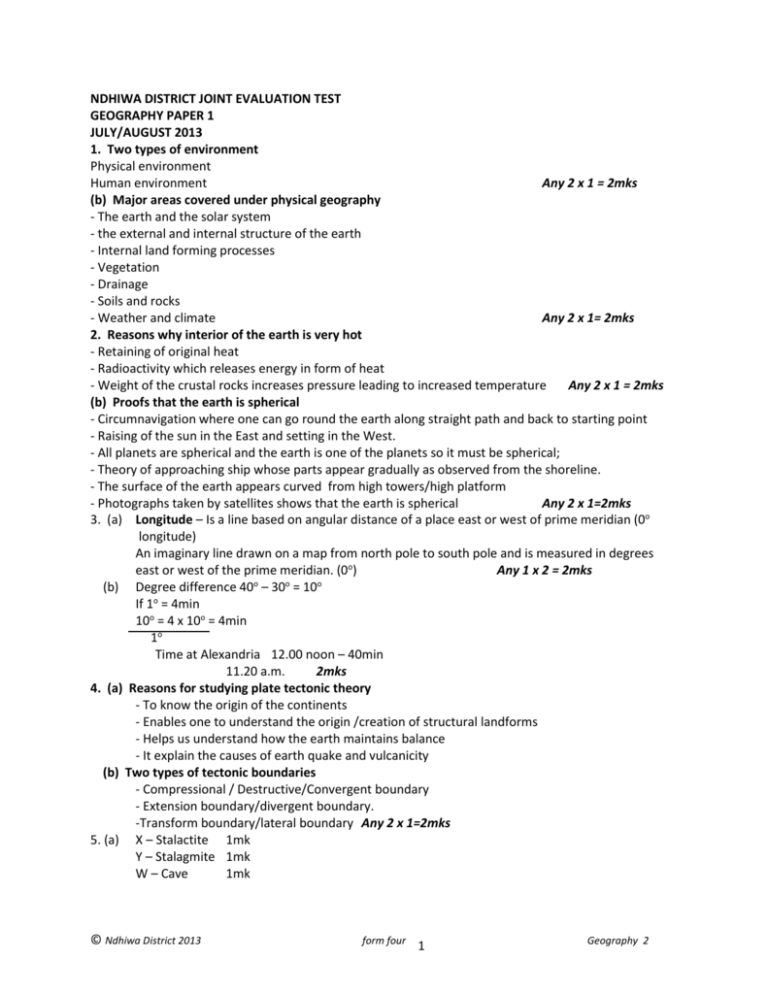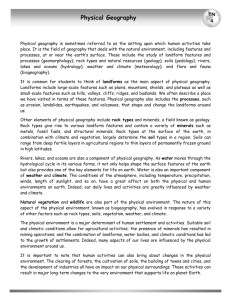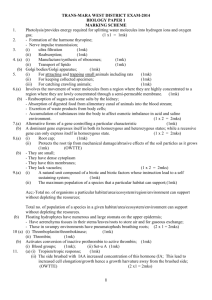NDHIWA DISTRICT JOINT EVALUATION TEST GEOGRAPHY
advertisement

NDHIWA DISTRICT JOINT EVALUATION TEST GEOGRAPHY PAPER 1 JULY/AUGUST 2013 1. Two types of environment Physical environment Human environment Any 2 x 1 = 2mks (b) Major areas covered under physical geography - The earth and the solar system - the external and internal structure of the earth - Internal land forming processes - Vegetation - Drainage - Soils and rocks - Weather and climate Any 2 x 1= 2mks 2. Reasons why interior of the earth is very hot - Retaining of original heat - Radioactivity which releases energy in form of heat - Weight of the crustal rocks increases pressure leading to increased temperature Any 2 x 1 = 2mks (b) Proofs that the earth is spherical - Circumnavigation where one can go round the earth along straight path and back to starting point - Raising of the sun in the East and setting in the West. - All planets are spherical and the earth is one of the planets so it must be spherical; - Theory of approaching ship whose parts appear gradually as observed from the shoreline. - The surface of the earth appears curved from high towers/high platform - Photographs taken by satellites shows that the earth is spherical Any 2 x 1=2mks 3. (a) Longitude – Is a line based on angular distance of a place east or west of prime meridian (0o longitude) An imaginary line drawn on a map from north pole to south pole and is measured in degrees east or west of the prime meridian. (0o) Any 1 x 2 = 2mks (b) Degree difference 40o – 30o = 10o If 1o = 4min 10o = 4 x 10o = 4min 1o Time at Alexandria 12.00 noon – 40min 11.20 a.m. 2mks 4. (a) Reasons for studying plate tectonic theory - To know the origin of the continents - Enables one to understand the origin /creation of structural landforms - Helps us understand how the earth maintains balance - It explain the causes of earth quake and vulcanicity (b) Two types of tectonic boundaries - Compressional / Destructive/Convergent boundary - Extension boundary/divergent boundary. -Transform boundary/lateral boundary Any 2 x 1=2mks 5. (a) X – Stalactite 1mk Y – Stalagmite 1mk W – Cave 1mk © Ndhiwa District 2013 form four 1 Geography 2 (b) (c) Artesian basin – Is a saucer shaped depression consisting of a layer of permeable rock that is sandwiched between two layers of impermeable rocks. (2mks) Factors Influencing Development of Karst scenery. - Surface rocks of the rock beneath should be thick limestone / Dolomite or chalk - The rock should be hard and well jointed - Climate should be hot and humid - Water table should be deep below the surface so as to destroy surface feature. SECTION B 6. (a) (i) Dry weather road Bridge any 1 x 1 = 1mk (ii) - Contours - Trigonometrical stations Any 2 x 1 = 2mks - Spot height (iii) Annual change = 2o25I Magnetic Declination as at 1960 = 2o23I Differencein years 1969-1960 = 9years 1 year = 2025’ 9 years = ? 9 x 2o25I = 21.753o = 21.41I 1 o 2 23I + 21o41I = 21.753o64I (b) (i) Complete square = 6 Incomplete squares = 15 Area = 6 + ½ (15) =6+7.5 =13.5km20.5 (ii) 10.5 km ± 0.1 (c) (iii) How relief has influenced settlement - Rugged landscape along the escarpment discourage settlement - Depressions occupied by the swamp discourage settlement - Gentle undulating area attract settlement (3315) - River valley discourage settlement especially along river Moigametet. Any 4 x 1 = 4mks (iv) Describing drainage - There are numerous rivers - Most of the rivers are permanent - Some rivers are parallel drainage pattern (Identify) - Generally, the rivers flow from North to South - There’s presence of papyrus and seasonal swamps - Presence of water reservoirs - Some rivers have dentrils drainage pattern (specify) © (i) Draw a rectangle bearing 10cm by 12cm between eastings 24 and 29, and northings 12 and 18, on the rectangle mark and name Seasonal swamps © Ndhiwa District 2013 form four 2 Geography 2 River Koitobos Road C641 Sandruns and bridge R ECTANGLE REPRESENTING THE AREA BETWEEN EASTINGS 24 AND 29 NORTHINGS 12 AND 18 Marking points - Correct outline and labeled -1mk - Features in relative position Seasonal swamp -1mk River koitobos -1mk Road C641-1mk Sandrun’s -1mk (d) Economic activities Dairy farming ; Transportation ; © Ndhiwa District 2013 cattle dip as 2826 roads C641 form four 3 Geography 2 Fishing ; Fishing hut; Gs 4225 Growing of trees/ Forestry; Kiptaberr forest Plantation/crop farming ; Wattle as 2412 Any 2 x 1= 2mks 7. (a) (i) 1 - Mediterranean climate 2 - Tropical continental 3 - Equatorial climate (ii) Characteristics of climate marked 5 - Mean monthly temperature is 280C and 100C during hot and cool seasons respectively - Annual temperature range is wide; 260C - Diurnal range of temperature is high - Rainfall is very low; less than 120 mm p.a. - Rainfall is occasionally accompanied by heavy storms Any 5 x 1 = 5mks (iii) Factors influencing climatic region labeled 1 - Nearness to the sea - Altitude - Ocean currents (c) (i) THREE water towers in Kenya Mt. Kenya Mau ranges Aberdare ranges Cherangany Mt. Elgon (ii) ii) FIVE measures taken in Kenya to conserve forests. 1. Legislation aimed at controlling careless cutting of trees 2. Afforest ration 3. Reforestation 4. Creation of forest reserves 5. Development other sources of energy 6. Agro – forestry 7. Encourage recycle of forest products (d) Adaptation of vegetation in Sahara and Namib - Some plants have long tap roots for withdrawing water deep underground - Some plants have small leaves to reduce water lose through transpiration - Some plants have thick back to store water - Some plants have shallow roots system root system to take moisture from soil layer - Some plants have waxy and water proof backs to reduce water lose through cuticle/lenticels - Some plants shed off their leaves during dry season to prevent excess water lose - Some plants remain dormant during dry season but during wet season. Any 6 x 1 = 6mks 8. (a) Two types of faults (i) – Normal faults - Thrust fault - Reverse fault - Anticline earth arching fault - Transform fault - Anticlinal earth faults - Share faults Any 2 x 1= 2mks (ii) THREE faulting features - Faults scarps - Tilt blocks - Fault block - Rift valleys - Faults steps Any 3 x 1 = 3mks © Ndhiwa District 2013 form four 4 Geography 2 (b) (i) THREE host mountains found in East Africa - Pare - Nyandarua/Arberdarse - Usambara - Nandi hills - Ruwenzori - Mau ranges (ii) Formation of Host Mountain - Rock strata layer undergo compression forces - Two reversed faults develop - Side blocks subside /sink leaving the middle block standing Or The middle block is thrust upwards above the side blocks The upstanding block form horst mountain/block Mountain/ block Host Sinking Any 3 x 1 = 3mks Text Sinking 4 Diagram 1 5 THREE causes of vulcanicity - Faulting which develops cracks through which magama moves - High temperature which melts the rocks making them to flow easily - Pressure caused by overlying materials which forces the molten rocks towards earth surface - Percolating water which changes into steam thus heating the overlying rocks into molten state Any 3 x 1 = 3mks (ii) Two characteristics of shield volcano - Broad based - Have gentle slopes - Consists of basic rocks Any 2 x 1 = 2mks (d) Three economic importance of faulting to man - Depression formed due to subsidence form lakes which acts as fishing grounds/provide water for domestic and industry use - Features such as host blocks attract tourists who bring foreign exchange - Windward slopes of Block Mountains recieve heavy rainfalls which promotes agriculture / encourage settlement. - Faulting exposes minerals such as diatomite which when mined earn income when sold to industries - Faulted landscapes have waterfalls which encourage H. E. P generation - Faulted landscape discourages the construction of infrastructure - Faulting can lead to the destruction of property Any 3 x 2 = 6mks 9. (a) (i) Aridity is the state of insufficient moisture on the earth’s surface leading to scanty vegetation or lack of it while desertification is the slow but steady encroachment of desert-like conditions into formally productive agriculture land . (2mks) (ii) Two types of deserts (under surface) - Erg /sandy - Stoney/ reg / serir - Rock / Hamada - Badlands Any 2 x 1 = 2mks (iii) Reasons why wind action is more active in hot deserts than in cold deserts (c) (i) © Ndhiwa District 2013 form four 5 Geography 2 - Presence of loose unconsolidated materials of rock easily carried away by wind. Strong tropical storm in deserts leads to high velocity winds - Absence of vegetation hence no obstruction to the wind load Any 2 x 2 = 4mks (b) (i) Abrasion ; Is the fractional erosion/mechanical erosion caused by the wind borne materials as they grind, scrap and polish desert rock surfaces /features (2mks) (ii) Deflation; Is the blowing away of loose and dry unconsolidated materials like dust and fine sand particles by rolling and lifting them up on the ground cur respectively. (2mks) (iii) Attrition; wearing a way of windborne materials as they rub against each other during transportation. (2mks) (c) (i) Two factors that influence the transportation of materials by wind in deserts. - Nature of desert soils - Presence of desert vegetation -Water availability - Strength and speed of wind (ii) K - Horn L - Eddy current M - Prevailing wind. (d) (i) Three ways of preparing for field study - Carrying out previsit - Assembling necessary tours for the study - Formulating hypotheses and objectives - Preparing working schedule - Dividing the class into workable groups Any 3 x 1 = 3mks Plus any other relevant point (ii) Three information that would be collected through observation - Existing desertion - W erosion/ deposition features - Desert soils - Desert vegetation - Water availability 10. (a) (i) Formation of ice on high mountain - Due to low temp. , water vapour freezes and forms snow - Snow falls and accumulate on the mountain top / higher slopes - Snow continue piling and new layers exert pressure on the lower layers - Lower layer become compressed as air is expelled from spaces between snow particles - The compacted layers form spaces between snow particles - The compacted layer form ice. Any 3 x 1 = 3mks (ii) Ice masses on mountains in East Africa - Ice caps - Cirque glaciers Characteristics of (b) (i) A corrie - Deep rock basin - Has steep sides - Is arm-chair in shape / semi circular - Has a high back wall - Has reserve slope on the lower side © Ndhiwa District 2013 (Any 3 x 1 = 3mks) form four 6 Geography 2 (ii) Pyramidal peak - Has steep sides - Is surrounded by cirques - Is sharp rock pinnacle / horn - Has radiating system of arettes Any 3 x 1= 3mks (iii) Fiords - Have steep walls - Is U-shaped - Has narrow sea inlets - Has hanging valleys - Has deep waters - IS shallow seaward (Any 3 x 1 = 3mks) (c) Explaining three importance of glaciations to both physical and human environment - Easen transportation – glaciated lakes eg Great lakes of North America provide natural routes - Support agriculture – boulder clay plains, outwash plains are fertile agricultural lands - Fishing – sheltered waters in fiords provide suitable breeding grounds for fishing - Mining – Glacial erosion exposes minerals making it easy for mining - H.E.P Production – water fells from hanging valley are ideal for generating power. (d) (i) Formation of crag and tail A large block of rock stands on the path of coming glacier The moving ice plucks off weak rock fragment from upper size of the rock As the ice moves round and ores the resistance rock, it carries the erodes materials to the leeward side The leeward side does not experience erosion Eroded materials are deposited on the leeward side of the rock With time the moving ice smoothens the side of the incoming ice while deposited materials increase of the leeward side. The resistant rock is the crag and materials deposited on the lee side from the tail hence crag and tail (Any 4 x 1 = 4mks) (d) (a) - Till - Boulder clay - Eskers - Drumlins - Kames - Out wash plains - Terminus Moraines - Lateral moraine (Any 3 x 1= 3mks) (b) - Note taking - Taking photographs - Drawing sketches - Filling questionnaires -tallying any 2x1=2mks © Ndhiwa District 2013 form four 7 Geography 2








